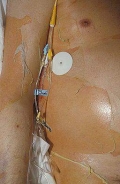AT ESHRE 2015
LISBON (FRONTLINE MEDICAL NEWS) – Advances in assisted reproductive technology (ART) have paid off, nearly halving the rate of ectopic pregnancy in the past 12 years.
The rate of ectopic pregnancy (EP) following ART progressively declined from 20 to 12 cases per thousand in a nationwide analysis of all ART pregnancies achieved in the United Kingdom between 2000 and 2012.
This trend appears to be related to a reduction in the incidence of tubal factor infertility, a lower number of embryos being transferred, and extended embryo culture, Dr. Nikolaos Polyzos said at the annual meeting of the European Society of Human Reproduction and Embryology.
Ectopic pregnancy (EP) is a rare event, occurring in only 2% of all spontaneous conceptions. ART has been consistently associated with higher rates of EP, which is the most common cause of mortality during the first trimester of pregnancy in the U.K., said Dr. Polyzos of the Centre for Reproductive Medicine at Vrije University Brussels.
Using the Human Fertilisation and Embryology Authority (HFEA) database, the investigators identified 684,247 ART cycles in the U.K. between 2000-2012, resulting in 212,877 pregnancies. After exclusion for various reasons including surrogacy, unspecified treatment, or missing data, 161,967 pregnancies were included in the analysis. Of these, 153,115 pregnancies occurred following in-vitro fertilization or intracytoplasmic sperm injection and 8,852 following intrauterine insemination.
The incidence of ectopic pregnancy was 1.4% over the 12-year study period.
In adjusted analyses, the most important independent risk factor for an ectopic pregnancy was tubal factor infertility, which more than doubled the risk (odds ratio, 2.23), Dr. Polyzos said.
Also significant was the number of embryos transferred (two vs. one; OR, 1.28; ≥ three vs. one; OR, 1.67) and extended embryo culture (day 3 vs. day 2; OR, 0.85; day 5 vs. day 2; OR, 0.73).
What this means in everyday clinical practice is that the probability of having an ectopic pregnancy is 29% per 1,000 pregnancies in a patient with tubal infertility if more than one embryo is transferred, he said. In contrast, the risk is more than three times lower at only 8.2% per 1,000 pregnancies in a patient who has a partner with male infertility and a single blastocyst transferred.
Details from the HFEA database showed that the proportion of infertile patients with tubal disease having ART progressively declined from 24% in 2000 to 12% in 2012. Tubal factor infertility accounts for about 14% of all infertility and is typically the result of Chlamydia trachomatis infection.
“Future efforts should promote national screening programs like the U.K.’s National Chlamydia Screening Programme. Although there is a discussion on how effective it is, I think it is very important we increase the uptake of these programs,” Dr. Polyzos said.
Efforts to promote widespread introduction of single-embryo transfer, which have been widely adopted in his own country, but less so in the United States, would lower the risk of EP even further, he added.
A recent U.S. analysis looking at the risk of EP associated with ART found that the rate of ectopic pregnancy was 1.6% when one embryo was transferred and 1.7%, 2.2%, and 2.5% when two, three, or four or more embryos were transferred, respectively. Overall, the EP rate declined from 2% in 2001 to 1.6% in 2011 based on 553,577 pregnancies reported during those years to the U.S. National ART Surveillance System ( Obstet. Gynecol. 2015;125:70-8 ).
ESHRE did not require reports of financial disclosures.
On Twitter @pwendl




